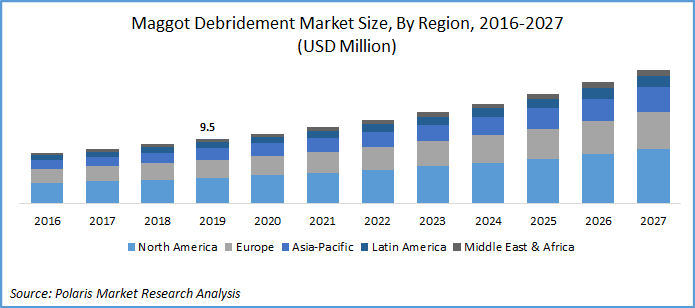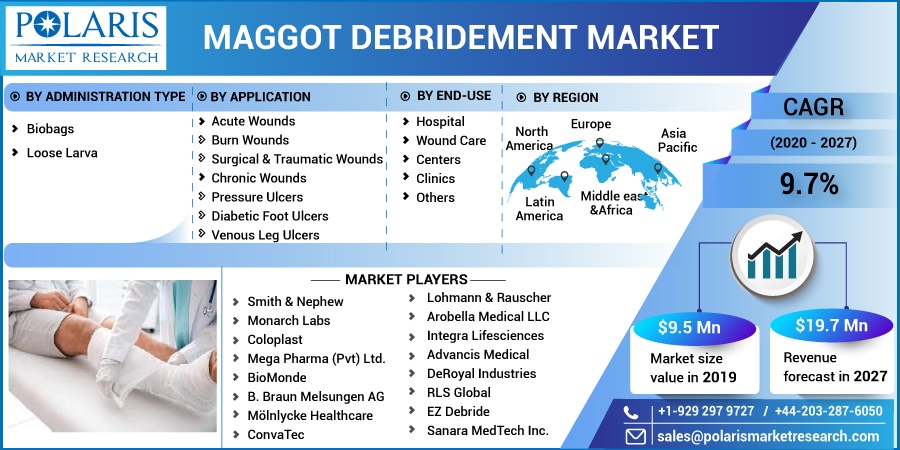
Maggot Debridement Market Share, Size, Trends, Industry Analysis Report
By Administration Type (Biobags, Loose Larva); By End Use (Hospital, Wound Care Centers, Clinics & Others); By Application; By Regions; Segment Forecast, 2020-2027
- Published Date:Dec-2020
- Pages: 98
- Format: PDF
- Report ID: PM1740
- Base Year: 2019
- Historical Data: 2016-2018
Report Outlook
The global maggot debridement market was valued at USD 9.5 million in 2019 and is expected to grow at a CAGR of 9.7% over the forecast period. Increasing chronic diseases i.e. diabetes, cancer, are the key factors responsible for the growth of the market. While prolonged diabetes is the reason for diabetic foot ulcers, the increasing cases of diabetes are predicted to positively influence the expansion of the maggot debridement market.
The biobags & loose larva are the most recent technology utilized in the treatment of venous leg ulcers, diabetic foot ulcers, and pressure ulcers. Moreover, the increasing incidences of burns & availability of reimbursement are further propelling the growth of the maggot debridement market.

Know more about this report: request for sample pages
Industry Dynamics
Growth Drivers
Cancer is a global concern as it is the leading cause of death. According to the World Health Organization (WHO), cancer is the major reason for death worldwide and approximately one in every six deaths happens because of cancer. In addition, over 70.0% of cancer-related deaths prevail in middle and lower-income level countries due to the increasing cases of chronic conditions.
Increasing cases of trauma, burns, and street accidents globally are expected to fuel the maggot debridement market growth. As per the World Health Organization (WHO) in 2018 around 1,000,000 people in India have gone through severe or moderate burns. Besides this, according to the NCBI, in 2017, countries including Finland, Bulgaria, South Korea, the Netherlands, China, and the U.K. has registered a rise in the cases of burn wounds.
 Know more about this report: request for sample pages
Know more about this report: request for sample pages
According to the American Association for the Surgery of Trauma, in 2017, nearly 1.2 million people died worldwide, and road accidents registered for around 3,242 deaths every day. Biomaterials & skin substitutes are widely utilized in healing all types of burn wounds. Hence, the rising number of accidents has led to the demand for the products, which is anticipated to drive maggot debridement market growth over the forecast period.
Maggot Debridement Market Report Scope
The maggot debridement market is primarily segmented based on administration type, application, end-use, and geographic region.
|
By Administration Type |
By Application |
By End-Use |
By Region |
|
|
|
|
Know more about this report: request for sample pages
Insight by Administration Type
Based on product type, the global maggot debridement market is categorized into Biobags, and Loose Larva. Comparatively, biobags segment held the major market share, in 2019, due to the increasing occurrence of chronic wounds & rising surgeries globally. While the Biobags are safe & reliable for usage and delivers outcomes in just 28 days. Furthermore, the segment is expected to witness significant growth over the projected period.
Loose larva wound debridement treatment is an old and conservative process. A dosage of 5-8 larvae per/sq. cm is administered directly within the wound and an outer dressing is developed to contain the larva to the therapy area. The entire treatment process takes around 14 days for wound debridement. However, in comparison with the biobags, the loose larva is not as safe to use, which might hamper the segmental growth for the global maggot debridement market over the forecast period.
Insight by Application
Based on application, the global maggot debridement market is categorized into acute and chronic wounds. The chronic wound segment held a significant share in 2019. The segment is expected to witness significant growth over the projected period as maggot debridement is widely used in chronic wounds. Meanwhile, chronic wounds include venous leg ulcers, diabetic foot ulcers, and pressure ulcers.
Additionally, the pressure ulcer segment is expected to achieve the fastest growth rate during the forecast period. Pressure ulcers or bedsores usually occur owing to the intense pressure on the skin for a larger time. It is widely caused by hospital stays & is commonly seen in the geriatric population. In addition to this, pressure ulcers prevail mostly at the bony areas of the human body including hips, ankles, and tailbone. However, increasing the geriatric populace globally is a key factor fueling the maggot debridement market segment.
Insight by End Use
Based on end-use, the global maggot debridement market is categorized into hospitals, wound care centers, clinics, and others. Hospitals held a significant market share, in 2019, due to the rising cases of chronic wounds. Additionally, rising cases of diabetic foot & venous leg ulcers are the key factors fueling the growth of the segment. However, the surgical wounds incidents are rising leading to an increase in the surgeries further propelling the growth of the segment.
Geographic Overview
Based on the region, the global maggot debridement market has been categorized into North America, Europe, Latin America, Asia Pacific, and Middle East & Africa. Among all, North America has the dominant market share. Rising cases of sports injuries, an increasing number of road accidents & the presence of various key players in this region are the major factors witnessed to propel the market growth. Additionally, the presence of developed healthcare infrastructure and adequate reimbursement policies are projected to fuel the growth of the regional maggot debridement market.
Asia Pacific is witnessed to achieve significant growth over the forecast period owing to the presence of the emerging economies including India, China & Japan. Additionally, the expanding medical tourism industry in this region is further responsible for the rising demand for these products in this region. For example, as per the report of Export Health Services by Directorate-General of Commercial Intelligence and Statistics of India, in 2016, India had around 58,300 medical tourists.
Competitive Insight
Key players operating in the global maggot debridement market are concentrating on joint ventures, collaborations, regional expansion, and investments for fortifying their worldwide impressions by entering into undiscovered markets. Additionally, the companies are also focusing on the research and development to develop technologically advanced products to sustain in the competition.
Smith & Nephew has a wide product portfolio in the global market including surgical gels, devices, and ointments. Owing to its wide product portfolio & good brand image, the company can secure its dominating position in the global maggot debridement market. Additionally, the company has a wide distribution channel in 100 countries globally. Moreover, the company has well-established marketing channels in developed markets including the US, which had generated 50% of its revenue from the US alone in 2019.
Some of the major players operating the global maggot debridement market include Smith & Nephew, Monarch Labs, Coloplast, Mega Pharma (Pvt) Ltd., BioMonde, B. Braun Melsungen AG, Mölnlycke Healthcare, ConvaTec, Lohmann & Rauscher, Arobella Medical, LLC Integra Lifesciences, Advancis Medical, DeRoyal Industries, RLS Global, EZ Debride & Sanara MedTech Inc.
